It looks like you're using an Ad Blocker.
Please white-list or disable AboveTopSecret.com in your ad-blocking tool.
Thank you.
Some features of ATS will be disabled while you continue to use an ad-blocker.
share:
For this, my third installment, I present to you a selection of unexplained artifacts. If you enjoy this thread, you may wish to take a look at the
first two in my ongoing series: Mysterious People and
Enigmatic Inscriptions
Glozel Tablets
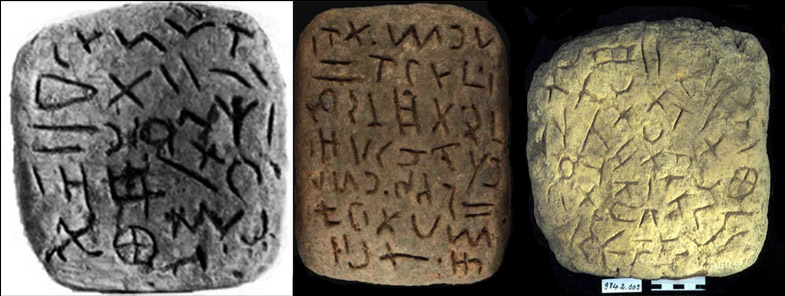 Three of the approximately 100 Glozel ceramic tablets
Three of the approximately 100 Glozel ceramic tablets
In 1924, in the hamlet of Gozel near Vichy in the southwest of France, 17 year-old Émile Fradin was plowing a field with a cow-drawn plow when the cow stepped in a hole and became stuck. While freeing the cow, Émile and his grandfather Claude Farin, discovered that buried beneath the field was a chamber with a floor of 16 clay tiles and walls of clay bricks. The chamber was subsequently found to contain among other things, a human skull and other bones, crude ceramic vessels, a stone axe, and engraved stones.
The initial assessment by a teacher named Benoit Clément was that the site was Gallo-Roman and tentatively dated to the period 100-400 AD. The following year, a local physician and amateur archaeologist, Dr. Antonin Morlet, began excavations and two more chambers were discovered — these lined with stone and bearing even more artifacts. The story of the next few years is more than a thread on its own, but there were: visits by prominent archaeologists, allegations of fraud leveled by the director of the Louvre, defamation suits, police raids and decades of debate over the authenticity of the artifacts.
An in-depth treatment of these events is available at Glozel.net — I found it fascinating and well worth reading. All told, over 3,000 artifacts were discovered and despite the controversy over the discovery of the site and its earliest excavations, scientific analysis has proven the authenticity of many of the artifacts. From the Wikipedia page:
Research paper detailing scientific analysis of artifacts.
Here, I'll focus on the 100 or so ceramic tablets. Ceramic jugs, flint tools and ancient jewelry are all quite fascinating in their own regard, but these tablets contain a script, unknown anywhere else in the world and yet to be translated. A concise description from the Glozel Wikipedia page linked earlier:
Details of Hans-Rudolf Hitz's Celtic origin hypothesis available here. Excerpt:
Researcher and author, Dr. Derek Cunningham, hypothesizes a proto-cuneiform connection:
Glozel Tablets

In 1924, in the hamlet of Gozel near Vichy in the southwest of France, 17 year-old Émile Fradin was plowing a field with a cow-drawn plow when the cow stepped in a hole and became stuck. While freeing the cow, Émile and his grandfather Claude Farin, discovered that buried beneath the field was a chamber with a floor of 16 clay tiles and walls of clay bricks. The chamber was subsequently found to contain among other things, a human skull and other bones, crude ceramic vessels, a stone axe, and engraved stones.
The initial assessment by a teacher named Benoit Clément was that the site was Gallo-Roman and tentatively dated to the period 100-400 AD. The following year, a local physician and amateur archaeologist, Dr. Antonin Morlet, began excavations and two more chambers were discovered — these lined with stone and bearing even more artifacts. The story of the next few years is more than a thread on its own, but there were: visits by prominent archaeologists, allegations of fraud leveled by the director of the Louvre, defamation suits, police raids and decades of debate over the authenticity of the artifacts.
An in-depth treatment of these events is available at Glozel.net — I found it fascinating and well worth reading. All told, over 3,000 artifacts were discovered and despite the controversy over the discovery of the site and its earliest excavations, scientific analysis has proven the authenticity of many of the artifacts. From the Wikipedia page:
Glass found at Glozel was dated spectrographically in the 1920s, and again in the 1990s at the SLOWPOKE reactor at the University of Toronto by neutron activation analysis. Both analyses place the glass fragments in the medieval period. Alice and Sam Gerard together with Robert Liris in 1995 managed to have two bone tubes found in Tomb II C-14 dated at the AMS C-14 laboratory at the University of Arizona, finding a 13th-century date.
Thermoluminescence dating of Glozel pottery in 1974 confirmed that the pottery was not produced recently. By 1979, 39 TL dates on 27 artifacts separated the artifacts into three groups: the first between 300 BC and 300 AD (Celtic and Roman Gaul), the second medieval, centered on the 13th century, and the third recent. TL datings of 1983 performed in Oxford range from the 4th century to the medieval period.
Carbon-14 datings of bone fragments range from the 13th to the 20th century. Three C-14 analyses performed in Oxford in 1984 dated a piece of charcoal to the 11th to 13th century, and a fragment of an ivory ring to the 15th century. A human femur was dated to the 5th century. Some archaeologists dated the rune stones on a fantastic age (about 8000 BC). This was displayed by experts such as Dr. Lois Capitan as clumsy forgery. The reason is that ca. 8000 BC no meaningful civilization could have existed.[3]
Research paper detailing scientific analysis of artifacts.
Here, I'll focus on the 100 or so ceramic tablets. Ceramic jugs, flint tools and ancient jewelry are all quite fascinating in their own regard, but these tablets contain a script, unknown anywhere else in the world and yet to be translated. A concise description from the Glozel Wikipedia page linked earlier:
Some 100 ceramic tablets bearing inscriptions are among the artefacts found at Glozel. The inscriptions are, on average, on six or seven lines, mostly on a single side, although some specimens are inscribed on both faces.
The symbols on the tablets are reminiscent of the Phoenician alphabet, but they have not been conclusively deciphered. There were numerous claims of decipherment, including identification of the language of the inscriptions as Basque, Chaldean, Eteocretan, Hebrew, Iberian, Latin, Berber, Ligurian, Phoenician and Turkic.[4][5][6]
In 1982, Hans-Rudolf Hitz suggested a Celtic origin for the inscriptions, and dated them to between the 3rd century BC and the 1st century AD, suggesting a Gaulish dialect. He counts 25 signs, augmented by some 60 variations and ligatures. Hitz hypothesizes that the alphabet was influenced by the Lepontic alphabet of Lugano, itself descended from the Etruscan alphabet, reading some Lepontic proper names like Setu (Lepontic Setu-pokios), Attec (Lepontic Ati, Atecua), Uenit (Lepontic Uenia), Tepu (Lepontic Atepu). Hitz even claims discovery of the toponym Glozel itself, as nemu chlausei "in the sacred place of Glozel" (comparing nemu to Gaulish nemeton).
Details of Hans-Rudolf Hitz's Celtic origin hypothesis available here. Excerpt:
An examination of the Glozel inscriptions on stone, bone, and ceramic reveals a certain variability between the texts. The possibility that different writers came over an extended period of time to the "sacred site of Glozel" might explain this fact. Pilgrims came to Glozel in order to inscribe dedications and make offerings as a form of religious observance, and also in order to immortalize deceased people or noble families.
An important purpose of the visit was to acquaint oneself with the writing and to learn how to reproduce it. Glozel seems to have been a kind of writing school. This presumes contacts between different peoples, but all of them must have spoken a Celtic language in order to understand each other.
Relationship of the Inscriptions of Glozel to Other Iron Age Inscriptions
According to measurements made by thermoluminescence (McKerrell, 1999), about two-thirds of the tested ceramic objects from Glozel date to between 300 BC and 100 AD. I have reached the conclusion that a great number of the Glozel signs represent letters which are similar to letters in related alphabets in use from the Iron Age to the Gallo-Roman period.
In comparing the Glozel inscriptions with these written languages, one finds close relationships with the Celtic texts from Transalpine Gaul (Gallo-Greek and Gallo-Latin), with the Celtic inscriptions (Lepontic and Cisalpine Gaulish) in use in Cisalpine Gaul (the north of Italy and southern Switzerland), as well as with the Greek, Etruscan, and Latin alphabets.
Researcher and author, Dr. Derek Cunningham, hypothesizes a proto-cuneiform connection:
The Glozel Tablet thus appears to produce data consistent with prior studies of proto-cuneiform, and Irish Ogham. The same writing style is also found on much older archaic writing styles, such as the Paleolithic-era engraved stones uncovered in Shuidongguo in China, Blombos Cave in South Africa, and the circa 300,000 to 400,000 year old engraved bone of Bilzingsleben.
edit on 2014-9-12 by theantediluvian because: (no reason given)
(continued)
Additional resources not linked above:
MÖSSBAUER STUDY OF GLOZEL TABLET
French language site with pictures of the area, the excavation and several artifacts
Weissenhorn Tablets and a comparison to Gozel tablets (PDF).
BONUS!: The Weissenhorn tablets were also found by accident in debris dug up with a bulldozer (link above)!
BONUS 2! You may have noticed in one of the excerpts above, the mention of the Bilzingsleben carved bone. From Wikipedia:
California Cogged Stones
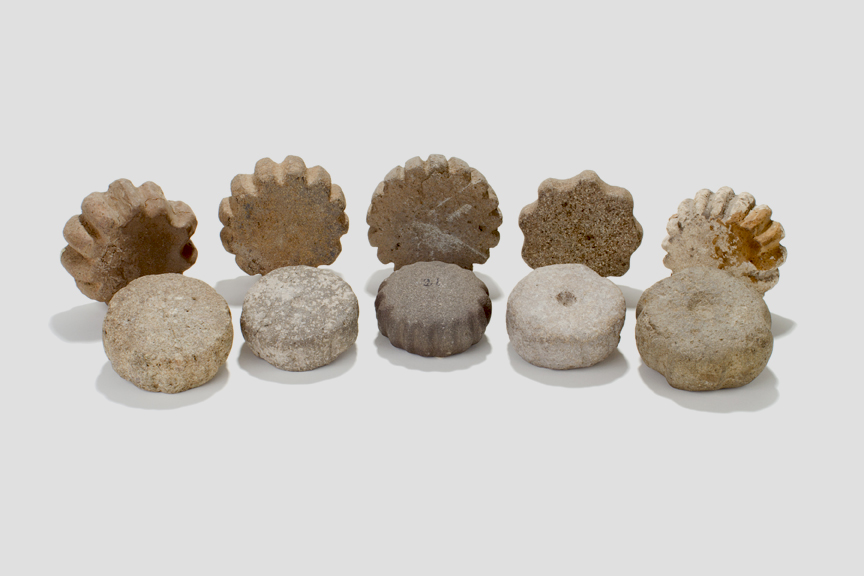 Part of the collection of cogged stones at the Bowers
Museum
Part of the collection of cogged stones at the Bowers
Museum
In modern times, the history of the cogged stones dates back to the late 1800's when the first examples were found in southern California. They were found with increasing regularity for the next several decades, with thousands of them being discovered. The stones have an average diameter of six inches or less, with about 15% of them having a perforation in the center. Discovery of the stones has been limited to a relatively small region as described in an excellent article by anthropologist (then Berkeley student) Devlin Gandy:
In case you missed that — they've been found in sites dating from roughly 5,500 BC - 3,000 BC. To put that in some sort of perspective: they first appear about the same time Sumer was being settled and were in use for 2,500 years — making the youngest stone about 500 years older than the first Egyptian pyramid. The stones were made of a very wide variety of materials and it appears that different tribes may have used materials specific to their own tribe. Once more from the Gandy article:
Dozens of uses have been proposed from stone machinery and fishing net weights to ceremonial objects and ancient game pieces. It's been hypothesized that they may represent some form of sea life such as jellyfish or as one of the more popular, recent theories holds, they might be symbolic representations of slices of columnar cacti. Stone machinery is of course one of the most fringe ideas, particularly when considering that the cogged stones are found among milling stones, hammer stones, scrapers, and spear points/arrowheads. It also bears mention that given the types of material these were made of and the lack of wear marks, the cogged stones were not likely used for any sort of utilitarian purpose.
One of the more interesting associations is their similarity to stone cogs found near the port city of Coquimbo, Chile. From Prehistoric America: An Ecological Perspective by Betty J. Meggers:
For one final clue to their significance, I return once more to Mr. Gandy:
Additional resources not linked above:
MÖSSBAUER STUDY OF GLOZEL TABLET
French language site with pictures of the area, the excavation and several artifacts
Weissenhorn Tablets and a comparison to Gozel tablets (PDF).
BONUS!: The Weissenhorn tablets were also found by accident in debris dug up with a bulldozer (link above)!
In the middle of the 1980ies there were found 9 carved Stone-Tablets with highly interesting inscripts on it. It was in the south of Germany, in the small City of "Weißenhorn".
Now it happened that we could locate the owner, who supplied us with Photos. (digital ones not yet in my possession). Seems to be a mixture between Tifinagh and Proto-Greek.
BONUS 2! You may have noticed in one of the excerpts above, the mention of the Bilzingsleben carved bone. From Wikipedia:
One bone fragment, an elephant tibia, has two groups of 7 and 14 incised parallel lines and might represent an early example of art. The regular spacing of the incisions, their subequal lengths and V-like cross-sections suggest they were created at the same time, with a single stone tool. The tibia dates to between 350,000 and 400,000 years ago.[1] The interpretation as an early calendar is a possibility.
California Cogged Stones

In modern times, the history of the cogged stones dates back to the late 1800's when the first examples were found in southern California. They were found with increasing regularity for the next several decades, with thousands of them being discovered. The stones have an average diameter of six inches or less, with about 15% of them having a perforation in the center. Discovery of the stones has been limited to a relatively small region as described in an excellent article by anthropologist (then Berkeley student) Devlin Gandy:
Dating cogged stones has been relatively difficult as most have been found in heavily plowed fields. Only a few of those found in situ are datable. Known dates and estimates place their appearance during the Early Milling Stone Horizon, some 7,500 years ago. Some 2,500 years later they disappear abruptly (Eberhart 1961 and Koerper 2006). Their range is centered along the Santa Ana River drainage in southern California's Orange and Riverside Counties. This extremely small geographic area contributes to their peculiarity. Though limited in range, some sites, like Bolsa Chica in Orange County, have revealed over 1,000 cogged stones in a few acres. On occasion, they have been found some distance from the Santa Ana River, known from isolated examples in Ventura and Los Angeles Counties, and as far east as Chandler, in south central Arizona.
In case you missed that — they've been found in sites dating from roughly 5,500 BC - 3,000 BC. To put that in some sort of perspective: they first appear about the same time Sumer was being settled and were in use for 2,500 years — making the youngest stone about 500 years older than the first Egyptian pyramid. The stones were made of a very wide variety of materials and it appears that different tribes may have used materials specific to their own tribe. Once more from the Gandy article:
Cogged stones were made from a range of materials including red ochre, steatite, tonolite, rhyolite, diorite, talc schist, calcium carbonate concretions, sandstone, siltstone, limestone, andesite, dactite, dolerite, pumice, basalt, and granite (Eberhart 1961, Underbrink 2006). Recent studies seem to indicate that the choice of stone was significant. It has been noted recently by Jeffrey S. Couch, Joanne S. Couch, and Nancy Anastasia Wiley, that cogged stones coming from the Cogged Stone Site (ORA-83) are made of different materials than its sister site, the Irvine Site (ORA64), even though both localities had ample access to the same materials. It appears that they chose to have distinct materials with which to fashion the artifacts that were to become the hallmarks of their sites during the same time period. It is therefore interpreted that specific stone types had tribal/clan affiliation (Couch, Couch, and Wiley 2009).
Dozens of uses have been proposed from stone machinery and fishing net weights to ceremonial objects and ancient game pieces. It's been hypothesized that they may represent some form of sea life such as jellyfish or as one of the more popular, recent theories holds, they might be symbolic representations of slices of columnar cacti. Stone machinery is of course one of the most fringe ideas, particularly when considering that the cogged stones are found among milling stones, hammer stones, scrapers, and spear points/arrowheads. It also bears mention that given the types of material these were made of and the lack of wear marks, the cogged stones were not likely used for any sort of utilitarian purpose.
One of the more interesting associations is their similarity to stone cogs found near the port city of Coquimbo, Chile. From Prehistoric America: An Ecological Perspective by Betty J. Meggers:
Chilean cogstones have the same range in size but are more varied in form; in addition to grooved or toothed disks, there are triangles quadrangles, and polygons with 24 or more facets. The material is always granite. Distribution in Chile is restricted to the province of Coquimbo and to sites earlier than 1500 B.C.
For one final clue to their significance, I return once more to Mr. Gandy:
As a whole, cogged stones show no utilitarian wear, and many are made out of lithic materials not valued for their durability. Interestingly, when Cogged Stones broke in antiquity—either in late manufacture or through use—they were carefully repaired with asphaltum. Pleistocene discoidals, an object found regularly with cogged stones and considered to be the cogged stone's closest cousin, show no such signs of care. Often, a discoidal's breaks are polished down leaving the stone asymmetrical. Asymmetry is not a common feature in cogged stones.
edit on 2014-9-12 by theantediluvian because: (no reason given)
Carved Stone Balls
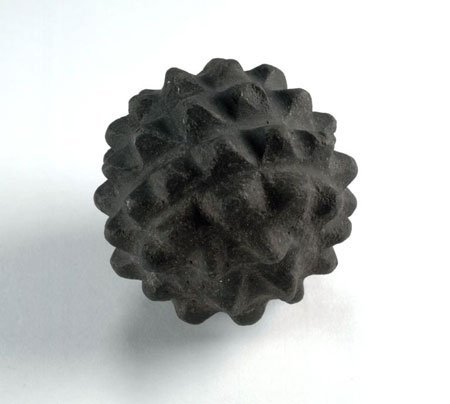 One of three balls found at Skara Brae
One of three balls found at Skara Brae
These strange carved petrospheres have been found for hundreds of years and placed in museum collections since at least late 19th century and nobody knows what their purpose was. Found almost exclusively in Scotland, the age of the balls for a long time remained as mysterious as their purpose since they were most often found during agriculture work such as plowing of fields.
However, some of the balls have been found in situ at neolithic sites such as Ness of Brodgar, Skara Brae and Dunadd and the accepted ages are in the 2000-3000 BC range.
From the Ashmolean Museum website:
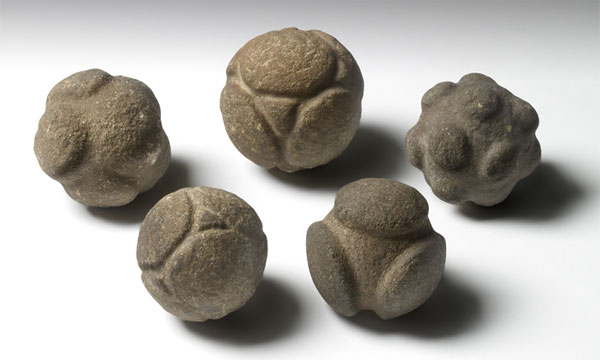 Five stone balls from the collection of Sir John Evans given to the Ashmolean Museum
Five stone balls from the collection of Sir John Evans given to the Ashmolean Museum
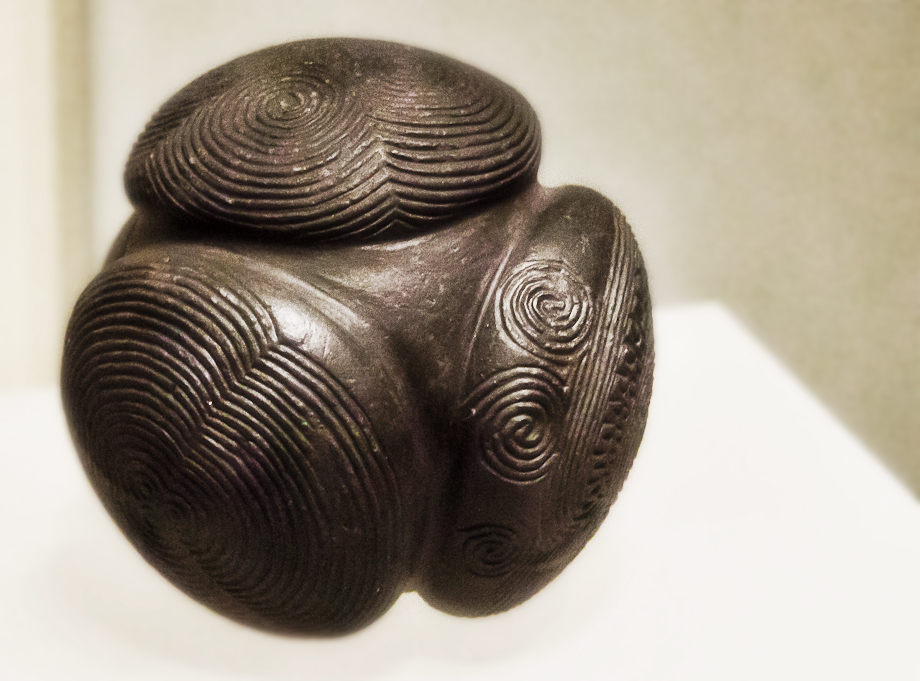 Ball found in Towie in Aberdeenshire
Ball found in Towie in Aberdeenshire
A few of the various theories listed on the Wikipedia page:
- Implement for divination (neolithic magic 8-ball?)
- Part of a weapon such a bola
- Fishing net weights (again with the fishing net weights!)
- Tools for leather working
- Equipment for primitive sport
- Megalith construction aid (bearing of sort)
Additional Resources:
British Museum
Orkneyjar - Orkney Islands heritage site
The Scottish Archaeological Research Framework website
Thanks for reading!

These strange carved petrospheres have been found for hundreds of years and placed in museum collections since at least late 19th century and nobody knows what their purpose was. Found almost exclusively in Scotland, the age of the balls for a long time remained as mysterious as their purpose since they were most often found during agriculture work such as plowing of fields.
However, some of the balls have been found in situ at neolithic sites such as Ness of Brodgar, Skara Brae and Dunadd and the accepted ages are in the 2000-3000 BC range.
From the Ashmolean Museum website:
Carved stone balls from Scotland are an enigmatic class of objects. They date to the late Neolithic or early Bronze Age, between 3200 and 1500 BC, and are made of various stones ranging from sandstone to granite. They are all of a relative similar size and are decorated with carved evenly-spaced patterns of circular bosses or knobs around the surface of the sphere. The designs vary with the majority being based around a series of six bosses, but the number of bosses varies from 3-160. Some carved balls are more skilfully manufactured than others, and a rare few have additional decoration. All show an appreciation for symmetry in the design.
Over 425 carved stone balls are now known, mainly from Scotland although a few have been found in northern England and Ireland. Most are isolated finds although a few have archaeological contexts, most notably the three found during excavations at the later Neolithic site at Skara Brae, Orkney, which are assumed to have had a ritual significance.
Despite their numbers, very little is known about carved stone balls and their purpose is still unknown. Very few of the balls are damaged or show any signs of use and they have not been found in contexts that would suggest a specific function. They are presumed to have been non-utilitarian objects with a symbolic or social significance to late Neolithic and early Bronze Age communities, and are most frequently interpreted as being indicators of power or prestige.


A few of the various theories listed on the Wikipedia page:
- Implement for divination (neolithic magic 8-ball?)
- Part of a weapon such a bola
- Fishing net weights (again with the fishing net weights!)
- Tools for leather working
- Equipment for primitive sport
- Megalith construction aid (bearing of sort)
Additional Resources:
British Museum
Orkneyjar - Orkney Islands heritage site
The Scottish Archaeological Research Framework website
Thanks for reading!
edit on 2014-9-12 by theantediluvian because: (no reason given)
Great Thread with some extrememy interesting information...
Living in France and not that far away from Glozel, methinks that a visit before the end of the year is needed.
I have already posted on another thread quite a while ago about the ball issue and this is my theory :
For me they are the original petanque gaming balls (funny that the one set of 3 was found as normally for one single person each person has 3 balls to play with as well as the smaller ball normally made out of wood or bone which is called the cochonnet).
History of petanque :
More here from someone who actually delved into the history of petanque : home.earthlink.net...
I really think that the set of 3 balls found together could have been an early complete set of the game which is now commonly known as petanque or Boules Lyonnaises.
Couple of images of fairly old dated petanque balls to modern day balls :
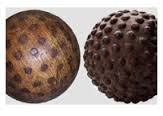
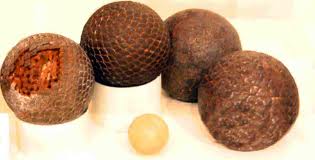


Notice a similarity?
And a modern day set purchased anywhere in a sports shop in France :
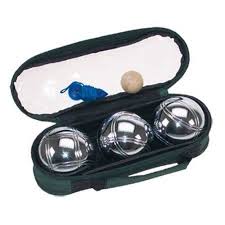
Maybe I am wrong... just chucking out what I think?
Kindest respects
Rodinus
Living in France and not that far away from Glozel, methinks that a visit before the end of the year is needed.
I have already posted on another thread quite a while ago about the ball issue and this is my theory :
For me they are the original petanque gaming balls (funny that the one set of 3 was found as normally for one single person each person has 3 balls to play with as well as the smaller ball normally made out of wood or bone which is called the cochonnet).
History of petanque :
More here from someone who actually delved into the history of petanque : home.earthlink.net...
I really think that the set of 3 balls found together could have been an early complete set of the game which is now commonly known as petanque or Boules Lyonnaises.
Couple of images of fairly old dated petanque balls to modern day balls :




Notice a similarity?
And a modern day set purchased anywhere in a sports shop in France :

Maybe I am wrong... just chucking out what I think?
Kindest respects
Rodinus
edit on 12/9/14 by Rodinus because: Crap spelling
a reply to: theantediluvian
I am purely looking and thinking so don't shoot me off my perch, its too esrly in the day and I am still very stiff in m y joints.
Could these balls be sling shot for hunting and even for local warfare? Just a thought. The cogged wheels are amazing and take me back to my theory that we might have our stone age the wrong way round.
Its simply that the stone-age people were so sophisticated and brilliant in their building, that I wonder if they are the last remnants of a pre-civilisation that existed prior to Sumer and whose majority died off during one of our many catastrophes - I just think when looking around my town that only the stone buildings would last a tsunami or similar destructive weathered force, the rest would be lost as debris which coulod be so displaced no one looking later would know where it came from originally.
I am purely looking and thinking so don't shoot me off my perch, its too esrly in the day and I am still very stiff in m y joints.
Could these balls be sling shot for hunting and even for local warfare? Just a thought. The cogged wheels are amazing and take me back to my theory that we might have our stone age the wrong way round.
Its simply that the stone-age people were so sophisticated and brilliant in their building, that I wonder if they are the last remnants of a pre-civilisation that existed prior to Sumer and whose majority died off during one of our many catastrophes - I just think when looking around my town that only the stone buildings would last a tsunami or similar destructive weathered force, the rest would be lost as debris which coulod be so displaced no one looking later would know where it came from originally.
originally posted by: Shiloh7
a reply to: theantediluvian
I am purely looking and thinking so don't shoot me off my perch, its too esrly in the day and I am still very stiff in m y joints.
Could these balls be sling shot for hunting and even for local warfare? Just a thought. The cogged wheels are amazing and take me back to my theory that we might have our stone age the wrong way round.
Its simply that the stone-age people were so sophisticated and brilliant in their building, that I wonder if they are the last remnants of a pre-civilisation that existed prior to Sumer and whose majority died off during one of our many catastrophes - I just think when looking around my town that only the stone buildings would last a tsunami or similar destructive weathered force, the rest would be lost as debris which coulod be so displaced no one looking later would know where it came from originally.
Those are big balls (pardon the expression) for sling shotting no? or the game was extremely large?
But of course the balls with the big grooves in them could have also been used as "Bola balls" for hunting (I can easily see how twine could be woven around the grooves).
Something tickles my brain also that those cogs were also "probably used" in some kind of game?
I think of gaming, as of course back in those days they had to do something else apart from hunting/gathering/surviving/dancing around in circles with skulls on their head and copulating? (humor has been added if course)
Kindest respects
Rodinus
edit on 12/9/14 by Rodinus because: Phrase added
a reply to: theantediluvian
Really enjoyed the thread
The writing on the tablets looks like an early Hebrew/Caananite language.
Really enjoyed the thread
The writing on the tablets looks like an early Hebrew/Caananite language.
Great thread. You put a lot of work into that. S&F!
This stuff always gets me thinking
This stuff always gets me thinking
Evidence of advanced technology all over the world exist, so I wonder why we insist on considering our ancestors as 'primitive'?
I love threads like this; thank you for writing it!
I love threads like this; thank you for writing it!
a reply to: Rodinus
They appear to be the right size and the protrusions are always symmetrical, which would be necessary to put the center of mass in the middle so that the balls would roll in a straight line.
As far as I know, they've never been discovered in a tomb and the contents of several tombs have been cataloged. I think this is very telling since the intricate engraving on many suggests that they were valued objects. Perhaps they were possessions held by a family or a village rather than by an individual? This could very well fit with a hypothesis of the carved balls being used for a sport in my opinion, though it doesn't preclude some of the others either.
They appear to be the right size and the protrusions are always symmetrical, which would be necessary to put the center of mass in the middle so that the balls would roll in a straight line.
As far as I know, they've never been discovered in a tomb and the contents of several tombs have been cataloged. I think this is very telling since the intricate engraving on many suggests that they were valued objects. Perhaps they were possessions held by a family or a village rather than by an individual? This could very well fit with a hypothesis of the carved balls being used for a sport in my opinion, though it doesn't preclude some of the others either.
originally posted by: zardust
a reply to: theantediluvian
Really enjoyed the thread
The writing on the tablets looks like an early Hebrew/Caananite language.
There are several characters that look like paleo-Hebrew or Phoenician (proto-Canaanite). That would make sense though since use of the Phoenician alphabet was extremely widespread and most modern writing systems can ultimately be traced back to it.
Of course, getting a toehold on the script is only a first step since as with modern languages, a great many languages employed a similar alphabet/phonetic script.
edit on 2014-9-12 by theantediluvian because: (no reason given)
a reply to: Shiloh7
As Rodinus pointed out, these are quite large for a slingshot projectile and I'm not sure the aerodynamic properties would be desirable but at this point, even the most learned scholars can only speculate.
a reply to: ABNARTY
a reply to: nugget1
Thanks! I've got a couple posts in the works and ideas for several more so I'll keep them coming!
As Rodinus pointed out, these are quite large for a slingshot projectile and I'm not sure the aerodynamic properties would be desirable but at this point, even the most learned scholars can only speculate.
a reply to: ABNARTY
a reply to: nugget1
Thanks! I've got a couple posts in the works and ideas for several more so I'll keep them coming!
a reply to: zardust
Lol, I was going to say Phoenician!
a reply to: theantediluvian
I'm enjoying your set of threads very much indeed and I've never heard of the cogged stones before - those are fascinating. How strange that they were repaired...I wonder if they were 'magical', talismans of sorts?
Lol, I was going to say Phoenician!
a reply to: theantediluvian
I'm enjoying your set of threads very much indeed and I've never heard of the cogged stones before - those are fascinating. How strange that they were repaired...I wonder if they were 'magical', talismans of sorts?
I'm commenting on this so that I can read it later when I'm home. Just wow.
a reply to: beansidhe
I found an interesting bit about commonalities in the arrangements in caches found at CA-ORA-83 in Saved by the Well: The Keystone Cache at CA-ORA-83, the Cogged Stone Site (PDF):
I found an interesting bit about commonalities in the arrangements in caches found at CA-ORA-83 in Saved by the Well: The Keystone Cache at CA-ORA-83, the Cogged Stone Site (PDF):
The typology offered here is supported by the grouping pattern found within the Keystone Cache and four other
caches from the site. There is a distinct spatial separation between Rectangular cogged stones and the others.
Rectangular group members are located in the center of the caches, surrounded by members of the other types. There is always a trapezoidal and/or Jell-O mold atop all the other cogged stones in the features. Approximately 50 percent or more of all Jell-O molds have white pigment residue on their larger faces. This is the only consistent painting/paint residue pattern among the cogged stones. One Jell-O mold is always upside down in each cache. None of the three or
more caches contain any odd-shaped cogged stones (such as those that are star-shaped). While the significance and meaning of these caching characteristics can be debated, what is evident is the consistency of the patterns observed. At a minimum, these patterns can help us properly associate and type these objects with greater fidelity than ever before.
a reply to: theantediluvian
Thank you, that is interesting and odd. So these 'cogs' are always found in groups, always with a 'Jell-O mould' shaped cog (half of which have residual white paint left on). That almost suggests that these were cogs, except that none have any sign of wear which in turn suggests that they were symbolic/ ceremonial/ornamental.
Aargh! How frustrating!
Many thanks for posting this, if I come across anything else I'll post it too.
Thank you, that is interesting and odd. So these 'cogs' are always found in groups, always with a 'Jell-O mould' shaped cog (half of which have residual white paint left on). That almost suggests that these were cogs, except that none have any sign of wear which in turn suggests that they were symbolic/ ceremonial/ornamental.
Aargh! How frustrating!
Many thanks for posting this, if I come across anything else I'll post it too.
a reply to: theantediluvian
The 'cogged' shapes are made mysterious by associating them with mechanical devices. However, the 'cogged' shape is used in the kitchen and nobody would really argue against that pattern/shape being just decorative. Would it be equally likely that ancient folk used the same decorative pattern in carvings?

Or would it be more likely that the stones were part of a stone gearbox? Not much, huh?
A thought crosses my mind that, perhaps, an astronomical event was visible in the North of Scotland and coincided with some fortuitous event? If so, maybe they represent a 'star' and held some religious/spiritual/superstitious importance?
Those Scottish carved spheres are superb and certainly mysterious in the sense we don't *know* what they were for. They're so appealing to the eye and artistic, I'd love to own one of the finely detailed ones or even a repro.
The 'cogged' shapes are made mysterious by associating them with mechanical devices. However, the 'cogged' shape is used in the kitchen and nobody would really argue against that pattern/shape being just decorative. Would it be equally likely that ancient folk used the same decorative pattern in carvings?

Or would it be more likely that the stones were part of a stone gearbox? Not much, huh?
A thought crosses my mind that, perhaps, an astronomical event was visible in the North of Scotland and coincided with some fortuitous event? If so, maybe they represent a 'star' and held some religious/spiritual/superstitious importance?
Those Scottish carved spheres are superb and certainly mysterious in the sense we don't *know* what they were for. They're so appealing to the eye and artistic, I'd love to own one of the finely detailed ones or even a repro.
a reply to: Kandinsky
I think the cogged stones are mysterious in much the same way as the carved stone balls:
1. A large number of specimens have been found.
2. Considerable effort was put into their manufacture.
3. They're not found outside of a relatively small area.
4. Their purpose is unknown but it doesn't appear to be one of utility.
What makes the cogged stones even more fascinating in my opinion, despite having somewhat less of an aesthetic appeal, is that they were present for approximately 2,500 years and disappear about 5,000 years ago and the connection with coastal Chile (and I believe I read somewhere Peru).
If you read the link to the research on the Keystone cache, there appears also to be a clear method behind the type and arrangement within the caches which seems very significant. A few of the more possible purposes that seem most plausible to me (in no particular order):
- totems of some sort (be it jellyfish, cacti, stars, etc) with religious significance, possibly used in religious ceremony/offerings.
- a form of currency
- a type of trophy
- some sort of measure of status
- pieces for a game
- sporting gear
I think the cogged stones are mysterious in much the same way as the carved stone balls:
1. A large number of specimens have been found.
2. Considerable effort was put into their manufacture.
3. They're not found outside of a relatively small area.
4. Their purpose is unknown but it doesn't appear to be one of utility.
What makes the cogged stones even more fascinating in my opinion, despite having somewhat less of an aesthetic appeal, is that they were present for approximately 2,500 years and disappear about 5,000 years ago and the connection with coastal Chile (and I believe I read somewhere Peru).
If you read the link to the research on the Keystone cache, there appears also to be a clear method behind the type and arrangement within the caches which seems very significant. A few of the more possible purposes that seem most plausible to me (in no particular order):
- totems of some sort (be it jellyfish, cacti, stars, etc) with religious significance, possibly used in religious ceremony/offerings.
- a form of currency
- a type of trophy
- some sort of measure of status
- pieces for a game
- sporting gear
a reply to: theantediluvian and Kandinsky
antidilluvian,
Thank you for posting the millingstone cultures cogs.
I somewhat familiar with the archeology of early California, but in all of the literature ive read I've seen no mention of these cogstones.
The most interesting bit about this is that in the region in question, several tribes never advanced past very crude peeble tools, they have been described a "Olduwan" in nature by Scotty Maccniesh.
I'm of the opinion that the millingstone horizon, was intrusive into earlier coastal cultures, likely from the san joaquin valley. I hate to say that the authors assertaion that Uto Aztecans migrated from Mexico, he got that backwards. Uto Aztecans have thier origins California.
The earliest verified millingstone sites are further north up the coast, with the earliest known manos & metate ( a cylindrical milling stone used with a flatish base stone) comes from the central valley. They were used to grind tule reeds and roots for food.
Kandinsky, there is no way they were mechanical parts, they have to have some sort aesthetic or ceremonial use.
But the use of red ochre in California, possibly foes back 200k years at calico Hills, in the mojave.
antidilluvian,
Thank you for posting the millingstone cultures cogs.
I somewhat familiar with the archeology of early California, but in all of the literature ive read I've seen no mention of these cogstones.
The most interesting bit about this is that in the region in question, several tribes never advanced past very crude peeble tools, they have been described a "Olduwan" in nature by Scotty Maccniesh.
I'm of the opinion that the millingstone horizon, was intrusive into earlier coastal cultures, likely from the san joaquin valley. I hate to say that the authors assertaion that Uto Aztecans migrated from Mexico, he got that backwards. Uto Aztecans have thier origins California.
The earliest verified millingstone sites are further north up the coast, with the earliest known manos & metate ( a cylindrical milling stone used with a flatish base stone) comes from the central valley. They were used to grind tule reeds and roots for food.
Kandinsky, there is no way they were mechanical parts, they have to have some sort aesthetic or ceremonial use.
But the use of red ochre in California, possibly foes back 200k years at calico Hills, in the mojave.
new topics
-
Late Night with the Devil - a really good unusual modern horror film.
Movies: 1 hours ago -
Cats Used as Live Bait to Train Ferocious Pitbulls in Illegal NYC Dogfighting
Social Issues and Civil Unrest: 2 hours ago -
The Good News According to Jesus - Episode 1
Religion, Faith, And Theology: 4 hours ago -
HORRIBLE !! Russian Soldier Drinking Own Urine To Survive In Battle
World War Three: 6 hours ago -
Bobiverse
Fantasy & Science Fiction: 9 hours ago -
Florida man's trip overseas ends in shock over $143,000 T-Mobile phone bill
Social Issues and Civil Unrest: 9 hours ago
top topics
-
Florida man's trip overseas ends in shock over $143,000 T-Mobile phone bill
Social Issues and Civil Unrest: 9 hours ago, 8 flags -
SETI chief says US has no evidence for alien technology. 'And we never have'
Aliens and UFOs: 13 hours ago, 7 flags -
Cats Used as Live Bait to Train Ferocious Pitbulls in Illegal NYC Dogfighting
Social Issues and Civil Unrest: 2 hours ago, 7 flags -
This is our Story
General Entertainment: 16 hours ago, 4 flags -
Former Labour minister Frank Field dies aged 81
People: 12 hours ago, 4 flags -
Bobiverse
Fantasy & Science Fiction: 9 hours ago, 3 flags -
HORRIBLE !! Russian Soldier Drinking Own Urine To Survive In Battle
World War Three: 6 hours ago, 2 flags -
Late Night with the Devil - a really good unusual modern horror film.
Movies: 1 hours ago, 2 flags -
The Good News According to Jesus - Episode 1
Religion, Faith, And Theology: 4 hours ago, 0 flags
active topics
-
Hi folks I'm Leon Grad
Introductions • 9 • : leongrad -
The Reality of the Laser
Military Projects • 41 • : 5thHead -
President BIDEN Vows to Make Americans Pay More Federal Taxes in 2025 - Political Suicide.
2024 Elections • 97 • : DBCowboy -
Thousands Of Young Ukrainian Men Trying To Flee The Country To Avoid Conscription And The War
Other Current Events • 136 • : NorthOS -
Cats Used as Live Bait to Train Ferocious Pitbulls in Illegal NYC Dogfighting
Social Issues and Civil Unrest • 8 • : lordcomac -
British TV Presenter Refuses To Use Guest's Preferred Pronouns
Education and Media • 140 • : Annee -
Florida man's trip overseas ends in shock over $143,000 T-Mobile phone bill
Social Issues and Civil Unrest • 16 • : grey580 -
HORRIBLE !! Russian Soldier Drinking Own Urine To Survive In Battle
World War Three • 22 • : RickyD -
SETI chief says US has no evidence for alien technology. 'And we never have'
Aliens and UFOs • 35 • : Consvoli -
Late Night with the Devil - a really good unusual modern horror film.
Movies • 1 • : DAVID64
